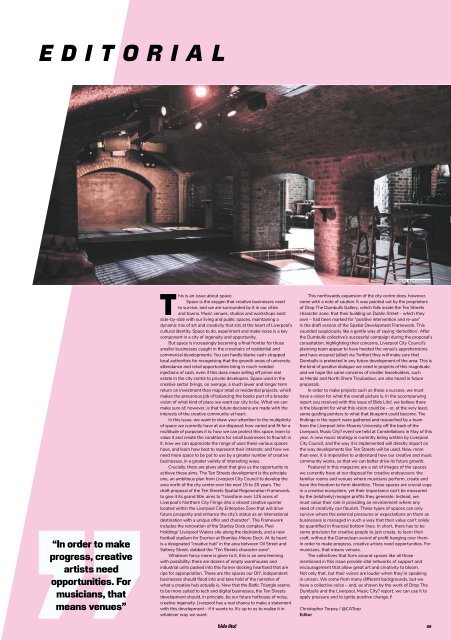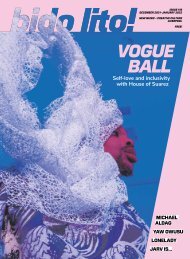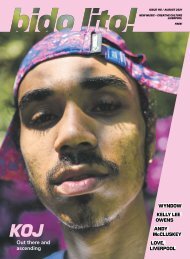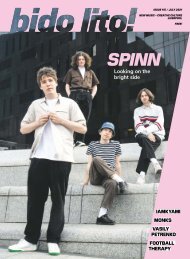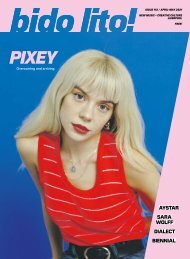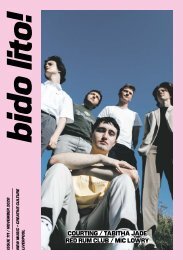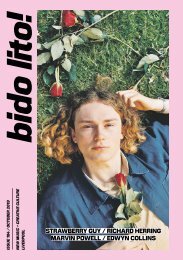Issue 84 / Dec 2017/Jan 2018
December 2017/January 2018 issue of Bido Lito! Featuring LO FIVE, TAYÁ, NICK POWER, MAC DEMARCO, LIVERPOOL MUSIC WEEK 2017 REVIEW and much more. Plus a special look at our need for space and independent venues, coinciding with a report into the health of Liverpool's music infrastructure.
December 2017/January 2018 issue of Bido Lito! Featuring LO FIVE, TAYÁ, NICK POWER, MAC DEMARCO, LIVERPOOL MUSIC WEEK 2017 REVIEW and much more. Plus a special look at our need for space and independent venues, coinciding with a report into the health of Liverpool's music infrastructure.
Create successful ePaper yourself
Turn your PDF publications into a flip-book with our unique Google optimized e-Paper software.
EDITORIAL<br />
EBGBS (Keith Ainsworth)<br />
“In order to make<br />
progress, creative<br />
artists need<br />
opportunities. For<br />
musicians, that<br />
means venues”<br />
This is an issue about space.<br />
Space is the oxygen that creative businesses need<br />
to survive, and we are surrounded by it in our cities<br />
and towns. Music venues, studios and workshops exist<br />
side-by-side with our living and public spaces, maintaining a<br />
dynamic mix of art and creativity that sits at the heart of Liverpool’s<br />
cultural identity. Space to do, experiment and make noise is a key<br />
component in a city of ingenuity and opportunity.<br />
But space is increasingly becoming a final frontier for those<br />
smaller businesses caught in the crosshairs of residential and<br />
commercial developments. You can hardly blame cash-strapped<br />
local authorities for recognising that the growth areas of university<br />
attendance and retail opportunities bring in much-needed<br />
injections of cash, even if this does mean selling off prime real<br />
estate in the city centre to private developers. Space used in the<br />
creative sector brings, on average, a much lower and longer term<br />
return on investment than major retail or residential projects, which<br />
makes the precarious job of balancing the books part of a broader<br />
vision of what kind of place we want our city to be. What we can<br />
make sure of, however, is that future decisions are made with the<br />
interests of the creative community at heart.<br />
In this issue, we want to draw your attention to the multiplicity<br />
of space we currently have at our disposal: how varied and fit for a<br />
multitude of purposes it is; how we can protect this space, learn to<br />
value it and create the conditions for small businesses to flourish in<br />
it; how we can appreciate the range of uses these various spaces<br />
have, and learn how best to represent their interests; and how we<br />
need more space to be put to use by a greater number of creative<br />
businesses, in a greater variety of interesting ways.<br />
Crucially, there are plans afoot that give us the opportunity to<br />
achieve these aims. The Ten Streets development is the principle<br />
one, an ambitious plan from Liverpool City Council to develop the<br />
area north of the city centre over the next 15 to 20 years. The<br />
draft proposal of the Ten Streets Spatial Regeneration Framework,<br />
to give it its grand title, aims to “transform over 125 acres of<br />
Liverpool’s Northern City Fringe into a vibrant creative quarter<br />
located within the Liverpool City Enterprise Zone that will drive<br />
future prosperity and enhance the city’s status as an international<br />
destination with a unique offer and character”. The Framework<br />
includes the renovation of the Stanley Dock complex, Peel<br />
Holdings’ Liverpool Waters site along the docklands, and a new<br />
football stadium for Everton at Bramley-Moore Dock. At its heart<br />
is a designated “creative hub” in the area between Oil Street and<br />
Saltney Street, dubbed the “Ten Streets character zone”.<br />
Whatever fancy name is given to it, this is an area teeming<br />
with possibility; there are dozens of empty warehouses and<br />
industrial units packed into this former docking heartland that are<br />
ripe for appropriation. These are the spaces our DIY, independent<br />
businesses should flood into and take hold of the narrative of<br />
what a creative hub actually is. Now that the Baltic Triangle seems<br />
to be more suited to tech and digital businesses, the Ten Streets<br />
development should, in principle, be our future hothouse of noisy,<br />
creative ingenuity. Liverpool has a real chance to make a statement<br />
with this development – if it wants to. It’s up to us to realise it in<br />
whatever way we want.<br />
This northwards expansion of the city centre does, however,<br />
come with a note of caution. It was pointed out by the proprietors<br />
of Drop The Dumbulls Gallery, which falls inside the Ten Streets<br />
character zone, that their building on Dublin Street – which they<br />
own – had been marked for “positive intervention and re-use”<br />
in the draft version of the Spatial Development Framework. This<br />
sounded suspiciously like a gentle way of saying ‘demolition’. After<br />
the Dumbulls collective’s successful campaign during the proposal’s<br />
consultation, highlighting their concerns, Liverpool City Council’s<br />
planning team appear to have heeded the venue’s apprehensions<br />
and have ensured (albeit via Twitter) they will make sure that<br />
Dumbulls is protected in any future development of the area. This is<br />
the kind of positive dialogue we need in projects of this magnitude,<br />
and we hope the same concerns of smaller leaseholders, such<br />
as Meraki and North Shore Troubadour, are also heard in future<br />
proposals.<br />
In order to make projects such as these a success, we must<br />
have a vision for what the overall picture is. In the accompanying<br />
report you received with this issue of Bido Lito!, we believe there<br />
is the blueprint for what this vision could be – or, at the very least,<br />
some guiding pointers to what that blueprint could become. The<br />
findings in the report were gathered and researched by a team<br />
from the Liverpool John Moores University off the back of the<br />
Liverpool, Music City? event we held at Constellations in May of this<br />
year. A new music strategy is currently being written by Liverpool<br />
City Council, and the way it is implemented will directly impact on<br />
the way developments like Ten Streets will be used. Now, more<br />
than ever, it is imperative to understand how our creative and music<br />
community works, so that we can better drive its future growth.<br />
Featured in this magazine are a set of images of the spaces<br />
we currently have at our disposal for creative endeavours: the<br />
familiar rooms and venues where musicians perform, create and<br />
have the freedom to form identities. These spaces are crucial cogs<br />
in a creative ecosystem, yet their importance can’t be measured<br />
by the (relatively) meagre profits they generate. Instead, we<br />
must value their role in providing an environment where any<br />
seed of creativity can flourish. These types of spaces can only<br />
survive where the external pressures or expectations on them as<br />
businesses is managed in such a way that their value can’t solely<br />
be quantified in financial bottom lines. In short, there has to be<br />
some provision for creative people to just create, to learn their<br />
craft, without the Damoclean sword of profit hanging over them.<br />
In order to make progress, creative artists need opportunities. For<br />
musicians, that means venues.<br />
The collectives that form around spaces like all those<br />
mentioned in this issue provide vital networks of support and<br />
encouragement that allow great art and creativity to bloom.<br />
Not only that, but their voices are louder when they’re speaking<br />
in unison. We come from many different backgrounds, but we<br />
have a collective voice – and, as shown by the work of Drop The<br />
Dumbulls and the Liverpool, Music City? report, we can use it to<br />
apply pressure and to ignite positive change. !<br />
Christopher Torpey / @CATorp<br />
Editor<br />
09


